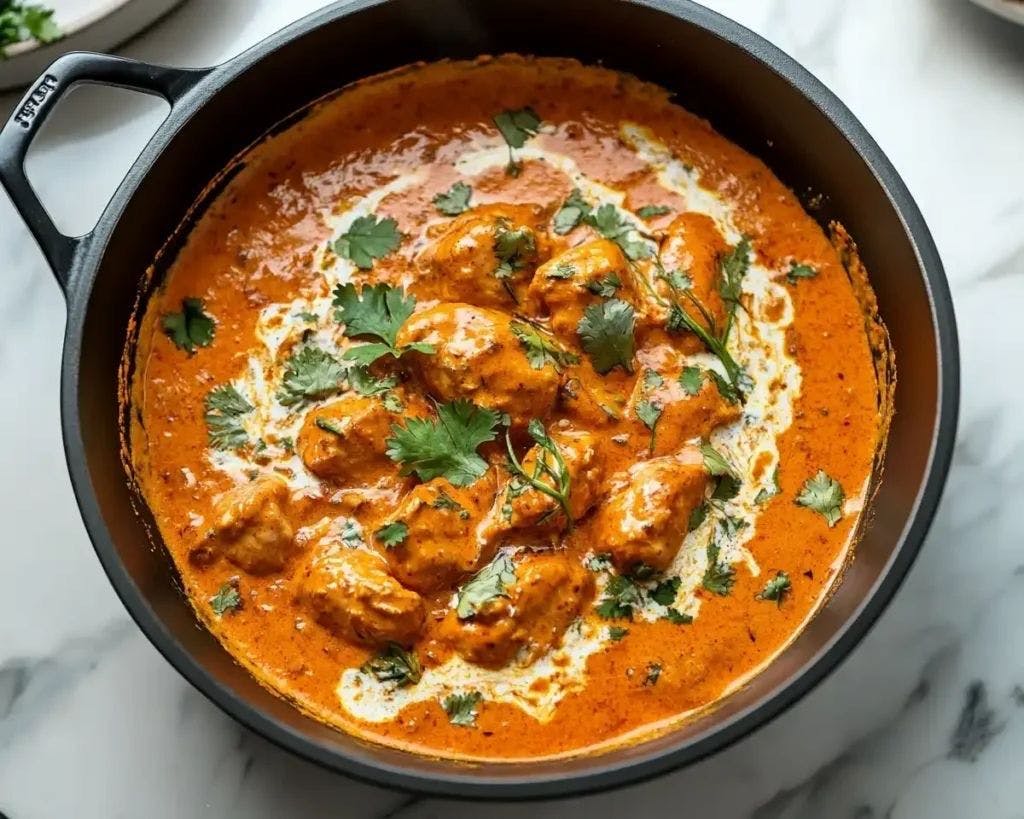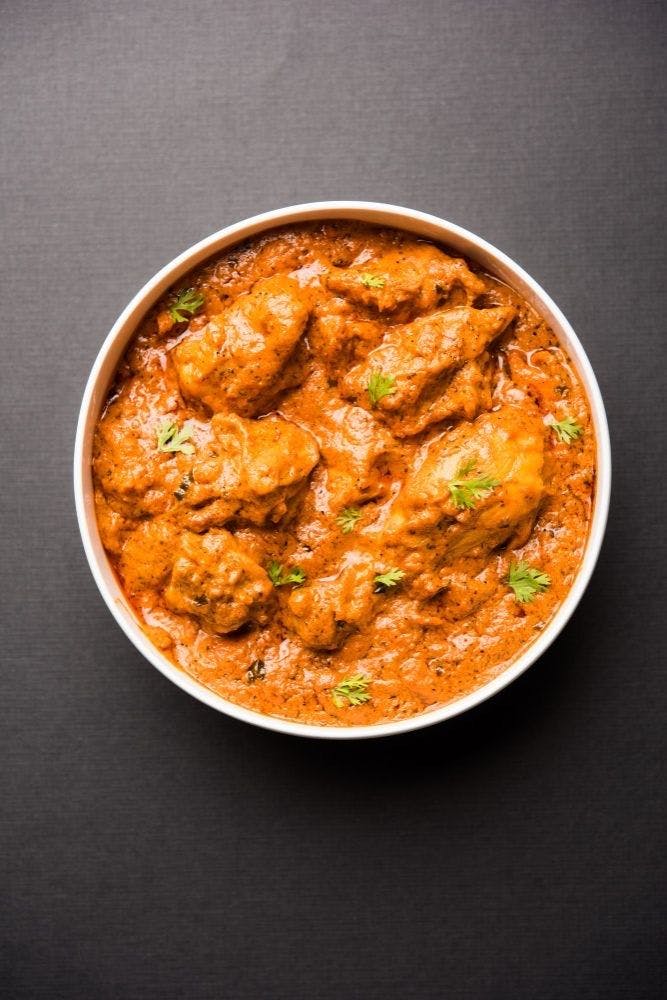Butter Chicken vs Tikka Masala: Best Choice for Office Catering

Written by CaterCow Staff • September 5, 2025

Indian food has become a staple for office catering across the U.S., and two dishes always top the list: Butter Chicken and Chicken Tikka Masala. Creamy, flavorful, and crowd-pleasing, they’re both excellent choices — but when you’re ordering an Indian buffet for 50-100 people, which one should you pick?
When it comes to Indian office catering, choosing dishes that please everyone can be a challenge. Two of the most popular Indian entrees—Butter Chicken and Tikka Masala—are both flavorful, saucy, and satisfying.
We spoke with four restauranteurs — Hemant Phul of Masala Times in New York, Karanbir Singh of Mirch Masala in Seattle, Alpa Patel Bhas of Eats Meets West Bowls in Redwood City, California, and Rohan Kumar of Tandoori Life Catering whose family roots trace back to New Delhi and Punjabi homestyle traditions— to uncover the real differences, what holds up best for events, and how to make the smartest choice for your next office lunch.
What’s the Difference Between Butter Chicken and Chicken Tikka Masala?
Butter Chicken is generally milder, creamier, and slightly sweeter, while Chicken Tikka Masala tends to be spicier, tangier, and more tomato-forward. But, ask four chefs, and you’ll get four different answers.
For Hemant Phul of Masala Times, the difference is in the chicken itself. “In essence, they’re the same dish,” he explains. “Butter chicken is made with pulled tandoori chicken — a mix of white and dark meat. Chicken Tikka Masala here in the States is made with cubes of boneless chicken, typically all white meat. The sauce is the same.”
But Singh of Mirch Masala sees it differently. “Butter chicken has a creamier tomato-based gravy with a quarter amount of cream. Tikka masala is more of a tomato-and-onion sauce with less creaminess.”
And then there’s Alpa Patel Bhas of Eats Meets West Bowls, who describes the difference in far more colorful terms: “Makhani [Butter Chicken] is the Bollywood love ballad — smooth, buttery, and rich. Tikka Masala? That’s the drama queen. Nobody even knows where it came from, but it doesn’t need an origin story — it is the story.”
The chefs at Tandoori Life Catering emphasize the spice balance, “Chicken Tikka Masala is definitely spicier, livelier, and lighter than Butter Chicken, which leans heavily on cream and ghee. We prefer Tikka Masala for events because it satisfies the palate and body at the same time.”

Butter Chicken vs Tikka Masala for Office Catering
When it comes to ordering for large groups, opinions split.
Chicken Tikka Masala is easier to portion because of its uniform chicken cubes. “For events, Chicken Tikka Masala is easier since it’s consistent,” the Masala Times owner shared. He makes both options available either as a buffet or an individually boxed meal.
On the other hand, the Mirch Masala owner recommends Butter Chicken above all else. “Its milder, richer, creamier flavor profile is preferred at lunch events. It’s our most popular dish for office catering.”
Some Indian caterers, like Eats Meets West Bowls sidestep the debate entirely by reinventing the dish. Their “All About the Makhani Bowl” lightens the traditional recipe with natural sweeteners like carrots and dates, and makes it customizable for any diet. “Don’t overthink it,” she advises. “You’re already stressed about whether the intern remembered plates. Just order bowls and call it a day.”
Do Butter Chicken and Tikka Masala Travel Well?
Butter Chicken is often considered the better option for long events because its cream-based sauce retains heat and texture longer than tomato-heavy curries. Butter Chicken can even retain its heat and flavor for 4-6 hours, according to Mirch Masala.
If your food needs to stay warm for an hour or two before serving, both dishes can handle the wait.“Both hold and travel well,” says Hemant. “It really comes down to personal preference.” Typically, traditional Indian buffets retain heat better than individually boxed meals.
Alpa adds her signature humor: “Our curries travel like Bollywood aunties — still hot, still fabulous, still gossiping all the way.”
Some Indian caterers on CaterCow like Tandoori Life even garnish on site, "Both dishes hold heat equally well. Our secret is to always garnish on-site — it makes the food taste like it just came off the stove.”

Authenticity and Recipe Variations
Butter Chicken and Chicken Tikka Masala are two of the most adapted Indian dishes worldwide, which means no two restaurants serve them exactly the same.
“There’s actually no butter in butter chicken,” Hemant points out. “The name refers to the buttery-smooth texture. Too many restaurants lean heavy on cream — balance is everything.”
Even though authentic butter chicken doesn't have butter, as Alpa notes "Makhani can be a butter bomb. Some places load it up like they’re trying to single-handedly keep the dairy industry in business."
Some restaurants use pre-mixed garam masala, while others grind their own. Even with the same spices, different ratios, cooking times, and cooking methods (wok, open fire, or clay oven) — it all changes the aroma and taste.
There can be regional differences as well: authentic Butter Chicken is mild, rich, and tomato-based, while Tikka Masala often has a stronger onion base.
Is either dish healthy?
“Spices like turmeric, cumin, coriander, ginger, and garlic don’t just add flavor — they help digestion, immunity, circulation, and overall balance in the body. That’s why we love offering Chicken Tikka Masala as our signature dish — it’s nourishing as well as delicious,” notes chef Simran from Tandoori Life.
So in some ways, the spice cabinet can also be a medicine cabinet. A good thing to keep in mind during the winter months as employee's wellness can wane.
Rice or Naan: What’s the Best Pairing?
Indian curries are famously versatile when it comes to sides.
“Rice is comforting, but naan is my go-to,” says Hemant. “Both rice and naan are preferable with butter chicken,” adds Karanbirsingh. Chef Simran confirms "Never skip basmati rice and garlic naan!”
For office catering, the safest bet is to offer both rice and naan, so employees can build their plates the way they like.
[[CCBanner type="office" href="https://www.catercow.com/dishes/indian-buffet"]]
Beyond rice and naan, ask your caterer for chopped onions and chilies on the side — it’s often free and elevates the dish. Dip onions in purple chutney for extra flavor.
Can Butter Chicken or Tikka Masala Be Made Vegan, Vegetarian, or Gluten-Free?
The good news for office admin and event planners is yes — both dishes can be adapted. Both Butter Chicken and Chicken Tikka Masala can be made vegetarian, vegan, gluten-free, or nut-free, making them excellent choices for inclusive office catering menus.
Vegetarian: Paneer is the most common swap. In India, Butter Chicken becomes Paneer Makhni; in the U.S., you’ll often see Paneer Tikka Masala.
Vegan: Some restaurants substitute tofu and coconut cream, though purists argue it changes the dish.
Dairy-Free: It can be possible to substitutes coconut cream and oat milk for dairy and uses vegan butter to recreate richness.
Gluten-free: Both curries are naturally gluten-free when served with rice; naan requires a gluten-free version.
Nut-free: Traditionally, both dishes are nut-free, but always confirm with the restaurant to avoid cross-contamination, particularly if making vegan substitutions as coconut can be unsafe for those with nut allergies.
Butter Chicken vs Tikka Masala Simplified
Here’s a quick comparison to help you decide:
| Feature | Butter Chicken | Tikka Masala |
|---|---|---|
| Origin | North India | Indian-British fusion |
| Sauce Base | Tomato, cream, butter, mild spices | Tomato, cream/yogurt, onions, bold spices |
| Flavor Profile | Mild, creamy, slightly sweet | Tangy, spiced, richer tomato flavor |
| Spice Level | Mild (spice-averse friendly) | Medium (adjustable) |
| Dietary Flexibility | Gluten-free, nut-free possible | Dairy-free, gluten-free, nut-free possible |
| Vegetarian Option | Yes (Paneer Butter Masala) | Yes (Paneer/Vegetable Tikka Masala) |
| General Likability | Universal crowd-pleaser | Popular with adventurous eaters |
| Mess Factor | Creamy sauce, can stain | Tomato-based, can stain more easily |
| Best Served With | Basmati rice, naan, roti | Basmati rice, naan, roti |
| Office Catering Tip | Great for mixed groups, safe choice | Offer as a second option for variety |
Butter Chicken is famous for its rich, creamy texture and mild spice. It’s a safe bet for groups with varying spice tolerances and is almost always a crowd-pleaser. The sauce is luscious and pairs perfectly with rice and naan, making it easy to serve.
Tikka Masala offers a tangier, more robust tomato flavor with a bit more spice. It’s great for teams who enjoy bolder tastes and can be made vegetarian or even dairy-free if needed. However, its vibrant sauce can be a bit messier, so be sure to provide plenty of napkins.

For Office Catering:
- Butter Chicken is ideal if you want a universally liked, mild option.
- Tikka Masala adds variety and is perfect for those who appreciate a little more kick.
- Both can be adapted for dietary needs and served alongside rice and bread for easy cleanup and portioning.
- Indian buffets let your team sample a bunch of flavors
Tip: For maximum satisfaction, offer both dishes—let your team sample and decide their favorite!
Whether you choose Butter Chicken, Chicken Tikka Masala, or both, pairing with rice and naan ensures everyone’s happy. Explore CaterCow’s curated selection of Indian catering options in major U.S. cities and make your next office lunch unforgettable.
Indian Catering Options Near You
- Atlanta Indian Catering
- Austin Indian Catering
- Boston Indian Catering
- Los Angeles Indian Catering
- NYC Indian Catering
- San Francisco Indian Catering
- San Jose Indian Catering
- Seattle Indian Catering
- Washington DC Indian Catering
- View Indian Buffets or Individually-packaged Indian Catering options by city
Butter Chicken vs Tikka Masala: FAQs
Is Butter Chicken the same as Chicken Tikka Masala?
They’re closely related but not always identical. Many U.S. restaurants use a similar sauce, but Butter Chicken is typically creamier and slightly sweeter, while Chicken Tikka Masala skews tomato-forward and a touch spicier. Some kitchens use pulled tandoori chicken for Butter Chicken and cubed boneless chicken for Tikka Masala.
Which dish travels and holds heat better for office catering?
Both travel well. Butter Chicken often retains heat and texture longer thanks to its cream base, making it a strong pick for events that hold food warm for 1–4 hours.
Which is milder: Butter Chicken or Tikka Masala?
Butter Chicken is generally milder, richer, and creamier. Chicken Tikka Masala tends to be a bit spicier and tangier from its tomato-onion base. Spice can be adjusted, but most chefs recommend keeping the house balance.
Can these dishes be made vegetarian, vegan, gluten-free, or nut-free?
Yes. Vegetarian versions often swap paneer (Paneer Makhni or Paneer Tikka Masala). Vegan versions may use tofu and coconut cream. Both are naturally gluten-free when served with rice (choose gluten-free naan if needed) and are typically nut-free—always confirm with your caterer for allergens and cross-contact.
What should I order for 50–100 people?
Order family-style trays and include both rice and naan for easy portioning. For broad appeal, pair mild Butter Chicken with a second entrée like Chicken Tikka Masala (or a paneer/vegan option) to cover different spice and diet preferences.



